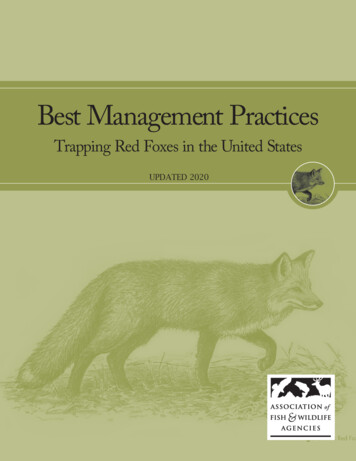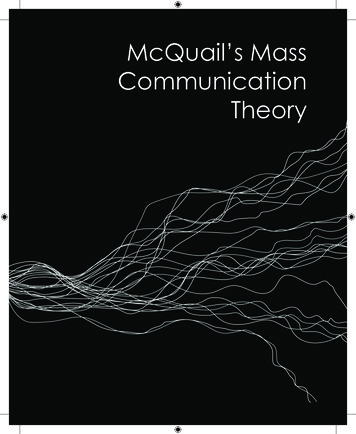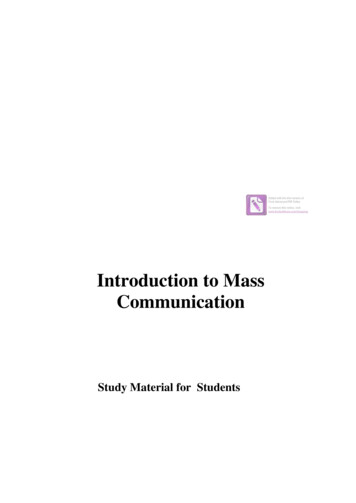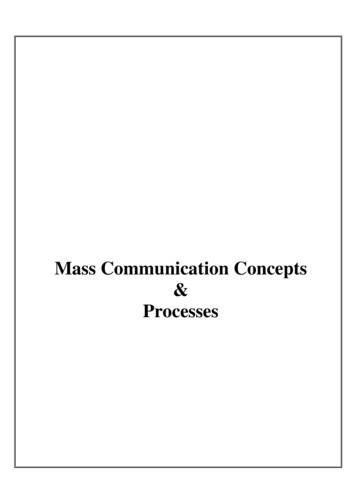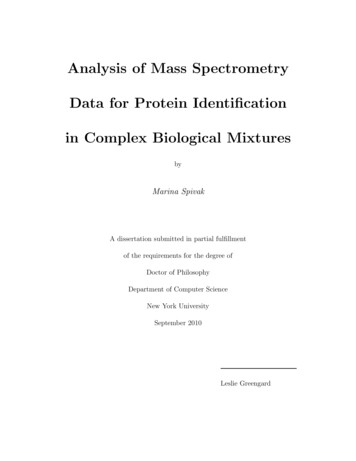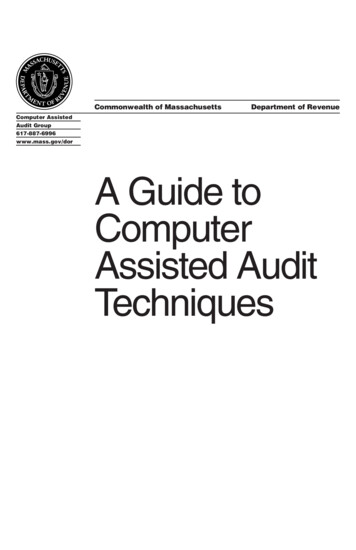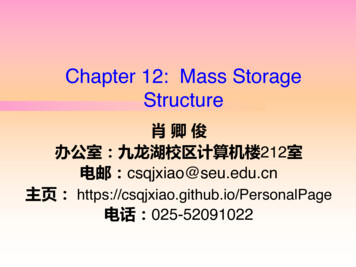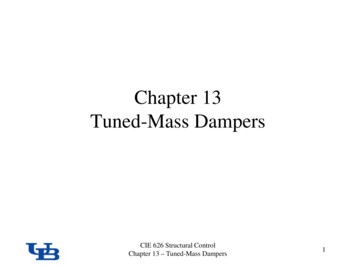
Transcription
10th International Working Conference on Stored Product ProtectionMass trapping of Ephestia kuehniella Zeller in a traditional flour millTrematerra, P.*# , Gentile, P.Department of Animal, Plant and Environmental Science, University of Molise, Via De Sanctis, 86100Campobasso, Italy. E-mail: trema@unimol.it* Corresponding author# Presenting authorDOI: 10.5073/jka.2010.425.107AbstractResults obtained by mass trapping method, using the synthetic pheromone (Z,E)-9,12-tetradecadienylacetate (TDA), to control the population of Ephestia kuehniella Zeller in a large traditional flour mill arereported. The surveys were carried out over a period of five years. Forty-two funnel traps, each baitedwith 2 mg of TDA, were placed in the mill on March 2004 and kept until November 2008. Eightadditional traps were located around the exterior of the facility, especially in the wheat silo area and nearloading equipment. In almost five years, the pheromone traps attracted a total of 54,170 male E.kuehniella. Considering only the catch data obtained from the traps located in the internal departments ofthe mill, 28,360 specimens were captured. Outside the plant, 1,975 males were trapped. From the trapcounts obtained it was possible to identify the locations of the main foci of infestation. With regard to thepest control attained by mass trapping techniques, trap catches of E. kuehniella inside the mill revealed aconspicuous decrease in the population density (of about 92.2%) comparing the data obtained in 2008with that from 2004. The population density of the pest outside the mill also decreased from the first untilthe last year of the surveys. The infestation was maintained at a low level, especially during the last twoyears of the study, when the Integrated Pest Management program applied in the plant did not includegeneral fumigations but only localized insecticide treatments and careful cleaning of the variousdepartments (wheat storage bins, processing and packaging areas, milling products warehouses and theloading zone) and the interior of all equipment.Keywords: Mediterranean flour moth, Mass trapping, IPM, Flour mill, Italy.1. IntroductionThe Mediterranean flour moth, Ephestia kuehniella Zeller (Lepidoptera: Pyralidae) is one of the majorpests in European cereal warehouses and food processing industries. If not controlled in the flour mills itsinfestations, it can be so abundant as to clog the flow of products in equipment. Furthermore, thepresence of larvae and webbing in the end product is unacceptable to consumers.In Italy, before the Montreal Protocol that limited methyl bromide use, control of insect pests inside millswas typically realized by one or two general fumigations per year and several contact insecticidetreatments, especially during the summer period (Trematerra and Gentile, 2006). Methyl bromide hasusually been replaced by sulfuryl fluoride or, in only a small number of industrial facilities, by nonchemical alternatives, generally in combination with spot insecticide treatments. In this context, for themajority of flour mills the number of chemical treatments using contact insecticides (natural pyrethrinsand synthetic pyrethroids but also organophosphates) has been increased, whereas preventive measures,such as good hygiene procedures, even if widely accepted as important in pest control, are often notadopted by mill managers.Several studies have been carried out in the last two decades to find effective alternatives to methylbromide and conventional chemical treatments or, in any case, of limiting their use. Among them havebeen investigation on the potential of pheromone-based methods (mass trapping, attract and kill ormating disruption techniques) to control indoor populations of E. kuehniella (Trematerra and Battaini,1987; Trematerra, 1988, 1990, 1994a and 1994b; Süss et al., 1996 and 1999; Anderbrant et al., 2007;Ryne et al., 2007; Trematerra and Gentile, 2010). Considering the mass trapping method, Trematerra &Battaini (1987) demonstrated that integrated control of E. kuehniella can be achieved by this technique inlimited environments. Furthermore, Trematerra (1988; 1990) reported results obtained in an entire largeflour mill: the practical application of mass trapping to control the infestation of E. kuehniella led to a748Julius-Kühn-Archiv, 425, 2010
10th International Working Conference on Stored Product Protectionreduction in chemical treatments, and as a consequence the mill obtained economic and qualitativeadvantages by protecting milling products from pesticide residues and improving the image of the firm.In the present paper, the results of applying the mass trapping method to contain the Mediterranean flourmoth infestation in a traditional flour mill are reported. Our researches focused on the effectiveness ofmass trapping, combined with other pest control techniques, at improving the procedures applied tocombat infestation by E. kuehniella in an Integrated Pest Management (IPM) approach.2. Materials and methodsThe surveys were carried out in a flour mill situated in Central Italy, over a period of almost 5 years,from March 2004 until November 2008. The plant is a building of 11,500 m3 with four floors, and itproduces about 70 tons of flour per day from processing spring wheat or hard wheat.Funnel traps (Mastrap type) with rubber dispensers baited with 2 mg of (Z, E)-9, 12-tetradecadienylacetate (or TDA) (daily release of 13 μg) were used. The dispensers remained effective for about 2months at which point they were replaced (traps and dispensers were supplied by Novapher, Italy).According with Trematerra and Battaini (1987), 42 traps were positioned in the mill, about one every270 m3, placed 2 to 2.5 m above the floor and 3 to 3.5 m from the walls. Eight traps were located at theexterior of the mill, especially in the wheat silo area and near loading equipment, sectors that arefrequently covered with grain, debris or dust. Trap captures were recorded weekly. Pipe joints were leftopen whenever processing was temporarily halted, i.e., during the holidays, so that the pheromone couldact on moths inside machinery. On the occasion of structural fumigations and chemical treatments withcontact insecticides, traps were removed and then reinstalled after 1 wk.For every sampling date, visual inspections were carried out to observe the presence of E. kuehniella freeadults, larvae, pupae or their traces, such as the larval silken webbing. These evidences, recorded asqualitative data, were reported every week to management personnel of the flour mill together with thenumber of the trapped moths. This was to assist them decisions making regarding measures to performagainst any critical situation found. Moreover, these observations, in addition to the trap catch data, werealso used in our study to evaluate the effect of mass trapping techniques and other IPM proceduresapplied in the mill.3. Results and discussionThe environmental conditions found inside the flour mill (monthly mean temperatures between 15 C and31 C from April to October, and between 8 C and 21 C from November to March) allowed thecontinuous development of the Mediterranean flour moth during eight to nine months every year, withapproximately one generation every two months (Bell, 1975).The captures obtained by the funnel traps positioned inside and outside the mill for every monththroughout the five years of the trial are represented in Figure 1. In the entire survey period, pheromonetraps attracted a total of 54,170 male Mediterranean flour moths. The insect pest was present in the millon almost all sampling dates. The traps located in the internal departments of the mill trapped 28,360specimens during 2004, 5,856 in 2005, 8,992 in 2006, 2,235 in 2007 and 2,218 in 2008. Outside thefacility, 1,975 males were captured in 2004, 1,405 in 2005, 1,005 in 2006, 1,010 in 2007, and 1,114 in2008.Julius-Kühn-Archiv, 425, 2010749
10th International Working Conference on Stored Product Protection12000Outdoor catchesNumber of males trappedIndoor catches9000600030000III V VII IX XI I III V VII IX XI I III V VII IX XI I III V VII IX XI I III V VII IX XI2004Figure 12005200620072008Cumulative monthly trap catches of Ephestia kuehniella males inside and outside the flour mill.The main peaks occurred during the summer months, July or August, whereas the population remained atlow levels from November until March, with few trap catches found. The increases recorded in thespring period, especially in May and June, are considered a consequence of emergence from the cocoonof the portion of the pest population that overwinters as mature larvae or pupae.After structural fumigations with both methyl bromide (carried out twice in 2004: in April and in August,and once in August 2005) and sulfuryl fluoride (carried out in August 2006), trap catches were almosttotally annulled for 2-3 weeks, however a rapid recolonization of the mill occurred, especially after of thespring fumigation of 2004.The highest numbers of males were recorded in traps positioned near machinery with ‘critical points’,where fairly constant large amounts of food resources or favorable environmental conditions are to befound. High levels of infestation also occurred in rooms where silos of milling products (flour, semolinaor bran) were located. Visual inspections confirmed this particular distribution of the pest. The positionof the main infestation foci of E. kuehniella in critical areas could be due to various causes:microclimatic suitability, interaction with biotic factors, processing practices, presence of doors andwindows and other physical attributes of a facility. The presence of the pest is a more frequent problemin all the departments where the possibility of finding flour, semolina, damaged grain, wheat debris ordust is regularly greater than that in other areas. Critical points such as the roll stands, the screenconveyors, the spouts, the plansichters, and the dust collectors, must be regularly and accuratelyinspected and cleaned. Other studies carried out in similar contexts indicate that there is a significantcorrelation between some of these factors and the spatial distribution of several insects in foodprocessing facilities and in flour mills (Trematerra & Sciarretta, 2004; Trematerra and Gentile, 2006).During the investigation, a higher presence of Mediterranean flour moth was observed on the groundfloor compared to the other sectors of mill, especially in sampling dates following fumigations or contactinsecticide chemical treatments. The assumption that the outdoor population might reinfest the flour millseems to be well founded because in this sector of the plant, during the summer period, it is easier forinsects to enter from outdoors and colonize the indoor departments. Investigations into the incidence ofstored-product moths of the genera Ephestia and Plodia outside warehouses and food-processingfactories were carried out at various locations (Wohlgemuth et al., 1987; Trematerra, 1988 and 1990;Süss et al., 1996; Doud and Phillips, 2000; Campbell and Mullen, 2004; Campbell, 2007). The resultsshow that during summer adults fly in the outdoors near these types of structures. Several surveyssuggest that a population of E. kuehniella outside storage facilities can potentially migrate inside.Although E. kuehniella is primarily associated with stored foods and is not considered to be a pest incrop fields, the immediate areas outside warehouses or food processing factories can represent important750Julius-Kühn-Archiv, 425, 2010
10th International Working Conference on Stored Product Protectionsources of infestation. Trematerra (1990) captured a great number of E. kuehniella males outside a flourmill in pheromone-baited traps. Trematerra (1990) and Süss et al. (1996) recorded rapid reinfestations byE. kuehniella in flour mills after fumigation with methyl bromide, and attributed these increases toimmigration by the outdoor population. Campbell and Arbogast (2004) found similar results whenassessing seasonal trends in E. kuehniella trap captures in a flour mill, the relationships between catchdata inside and outside the plant, between the number of trapped moths and product infestation, and theimpact of fumigation on the pest population.In our case, immigration by outdoor adult specimens has to be a limited phenomenon, since infestationremained at low levels without further important increases. On the other hand, the exiguous number of E.kuehniella adults observed by means of visual inspections in the inner departments of the plant, andconsequently, the low level of presence of free females, was in concordance with other mills controlledusing a mass trapping method (Trematerra and Battaini, 1987; Trematerra, 1990). Indeed, thepheromonal substance present inside the structure could induce the Mediterranean flour moth females toleave the internal areas in favour of the outdoor zones, and the absence of males could also stimulatedispersal.With regard to the pest control attained by mass trapping techniques, the trap catches of E. kuehniellainside the mill revealed a conspicuous decrease in the population density (of about 92.2%) comparingdata obtained in 2008 with that from 2004. The population density of the pest outside the mill alsodecreased from the first until the last year of the surveys, even though this reduction was smaller beingabout 44.6%.Further IPM strategies were employed in the flour mill during the hot seasons of the last three surveyyears. Mass trapping was accompanied by careful cleaning of the various departments (especially wheatstorage bins, processing and packaging areas, milling product warehouses and loading zone) and of theequipment interiors (in May and October 2006; April, June, August and October 2007; April, June,August and October 2008). This was done in tandem with localized chemical treatments with contactinsecticides of the critical sectors of the facility (in April, June, July and September 2006; May, July andSeptember 2007; May, July and September 2008) (Figure 1). These chemical treatments consisted ofspot surface spraying or space fogging of single infested rooms by means of synergized pyrethrum or, inareas with unusual problems, pyrethroids such as deltamethrin, permethrin or bioallethrin.The mass-trapping method accompanied with other pest control procedures was able to remove so manyE. kuehniella specimens as to ensure a low infestation level from the first year of the survey on. Thisprevented an increase in the residual population. It follows that the prolonged presence of funnel trapsled to a drastic reduction of insect presence in the entire facility. As reported by Knipling and McGuire(1966), we can likewise assume that the effectiveness of mass trapping was such that about 85-90% ofmales were captured. The effectiveness of the IPM program carried out in the mill during our researchrendered unnecessary the second general fumigation in 2005 and 2006. Afterwards, in 2007 and 2008,when the IPM program applied in the plant included regular cleaning procedures and localizedinsecticide treatments, no fumigation treatment was carried out; there was no increase in pest problems.Conversely, the fumigation treatments did not appear to impact trap captures of E. kuehniella for a longtime, probably because of high rates of immigration from the exterior.Considering the mass trapping method alone, its effectiveness is above all conditioned by the density ofthe population present in a structure. In our case assuming that a highly efficient trapping system hasbeen designed and an adequate trapping regime established, the problem of accurately assessing theeffects of the mass trapping treatment as a component of pest control still remains. IPM, in the strictestsense, includes the establishment of thresholds, at least at the level of economic injury. This is difficult todetermine in any environment where it is neither possible to measure the exact size of the pest populationnor to quantify the economic damage caused by a specific actual population size. In particular, for theMediterranean flour moth, an independent measurement of population density is still lacking (Ryne et al.,2006). Furthermore the risks of attack by this pest are often underestimated (Süss et al., 1996; Campbellet al., 2002). This means that IPM strategies in flour mills, to a much higher degree than in otherprocessing food plants or stored product areas, may be dependent on a strategy which includes a numberof preventive elements.Julius-Kühn-Archiv, 425, 2010751
10th International Working Conference on Stored Product ProtectionThe impressive reduction in the population density of E. kuehniella obtained in our surveys raises thequestion of whether “insectistasis” (Levinson and Levinson, 1985) can be obtained in a flour mill bymass trapping alone. Extrapolation of data recorded suggests that use of pheromone traps in a traditionalmill for a longer time should dilute the population density of the Mediterranean flour moth even further.However, it was not possible to eliminate infestation, or even reduce the level of “insectistasis”, iftrapping was not accompanied by insecticide treatment and general cleaning of the mill, particularly inthe corners and inside the machinery where the insects can hide and reproduce undisturbed. If suchmeasures are not observed, the mass trapping will, at best, only reduce the number of insecticidaltreatments.ReferencesAnderbrant, O., Ryne, C., Olsson, P.-O.C., Jirle, E., Johnson, K., Lüfstedt, C., 2007. Pheromones and kairomonesfor detection and control of indoor pyralid moths. IOBC/wprs Bulletin 30, 73-77.Bell, C.H., 1975. Effects of temperature and humidity on development of four pyralid moth pests of stored product.Journal of Stored Products Research 11, 167-175.Campbell, J.F., 2007. Interpretation of pheromone monitoring programs for stored-product insects. IOBC/wprsBulletin 30, 57-62.Campbell, J.F., Arbogast, R.T., 2004. Stored-product insects in a flour mill: population dynamics and response tofumigation treatments. Entomologia Experimentalis et Applicata 112, 217-225.Campbell, J.F., Mullen, M.A., 2004. Distribution and dispersal behavior of Trogoderma variable Ballion andPlodia interpunctella (Hübner) outside a food processing plant. Journal of Economic Entomology 97, 14551464.Campbell, J.F., Mullen, M.A., Dowdy, A.K., 2002. Monitoring stored product pests in food processing plants withpheromone trapping, contour mapping and mark recapture. Journal of Economic Entomology 95, 10891101.Doud, C.W., Phillips, T.W., 2000. Activity of Plodia interpunctella (Lepidoptera: Pyralidae) in and around flourmills. Journal of Economic Entomology 93, 1842-1847.Knipling, E.F., McGuire, J.U., 1966. Population models to test theoretical effects of sex attractants used for insectcontrol. U.S.D.A. Agriculture Information Bulletin 308, 1-20.Levinson, H.Z., Levinson, A.R., 1985. Use of pheromone traps for the proper timing of fumigation in the storageenvironment. EPPO Bulletin 15, 43-50.Ryne, C., Ekeberg, M., Jonzén, N., Oehlschlager, C., Löftedt, C., Anderbrant, O., 2006. Reduction in an almondmoth Ephestia cautella (Lepidoptera: Pyralidae) population by means of mating disruption. PestManagement Science 62, 912-918.Ryne, C., Svensson, G.P., Anderbrant, O., Löftedt, C., 2007. Evaluation of long-term mating disruption of Ephestiakuehniella and Plodia interpunctella (Lepidoptera: Pyralidae) in indoor storage facilities by pheromone trapsand monitoring of relative aerial concentrations of pheromone. Journal of Economic Entomology 100, 10171025.Süss, L., Locatelli, D.P., Marrone, R., 1996. Possibilities and limits of mass trapping and mating disruptiontechniques in the control of Ephestia kuehniella (Zell.) (Lepidoptera Phycitidae). Bollettino di Zoologiaagraria e Bachicoltura 28, 77-89.Süss, L., Locatelli, D.P., Marrone, R., 1999. Mating suppression of the Mediterranean flour
pest control attained by mass trapping techniques, trap catches of E. kuehniella inside the mill revealed a conspicuous decrease in the population density (of about 92.2%) comparing the data .
